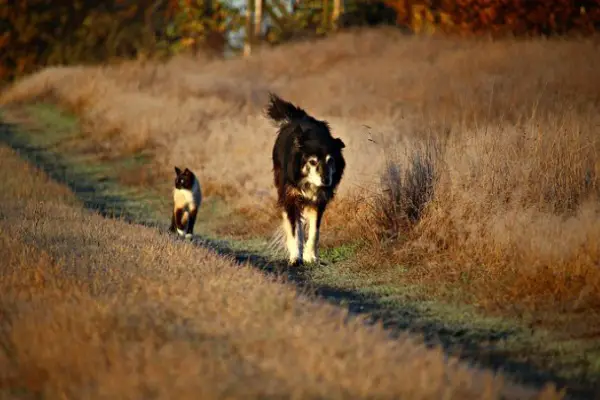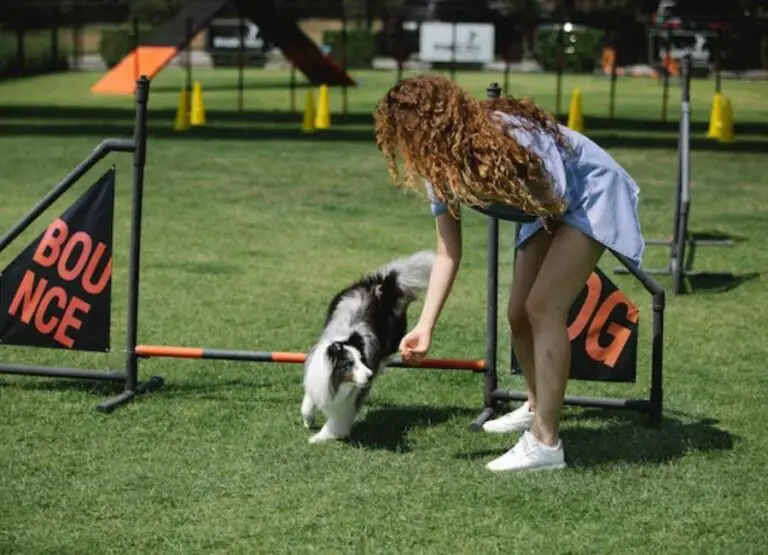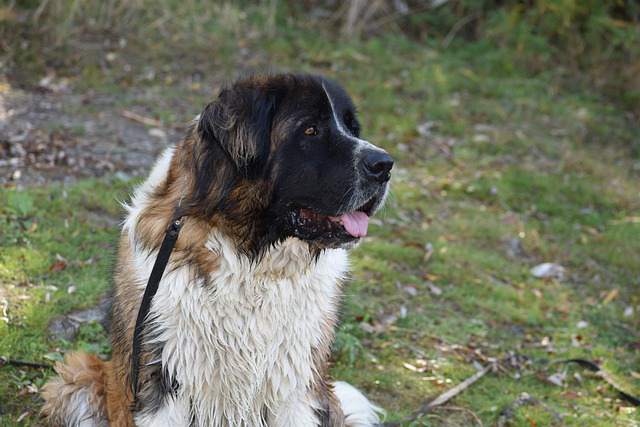Do Border Collies Get Along With Cats (A Complete Insight)

Do border collies get along with cats? This is a question that we will be discussing in this post, so keep reading!
Firstly, before we continue it is important you know that border collies are not the best breed of dog for cats because they were selectively bred to be herding dogs.
However, if you already have a border collie and want to add a cat to the mix, it’s fine as long as you are ready to put in the work.
In this post, I will highlight some advantages and disadvantages of having a border collie and a cat, then I will discuss ways to introduce both of them.
Do Border Collies Get Along With Cats
Border collies are high-energy dogs selectively bred to be herding dogs that may not get along with cats, however, because they are smart and quick to learn they can be trained to get along with cats.
Border collies do get along with cats if you get both pets from their puppy and kitten stages.
This is not to say that at adult stages border collies can’t get along with cats, they do get along but require more supervision.
Border Collies love chasing or herding things and can start chasing or herding this may be difficult for you and your cat.
All these issues can be resolved if you get both from a younger age.
Let’s quickly look at some pros and cons.
Advantages of getting a cat for border collies
Some of the most frequent reasons for obtaining a cat for your border collie are as follows:
- Border collies can benefit from owning a cat because separation anxiety is reduced or eliminated.
- Getting your border collie a cat might help him overcome some of his behavioral issues.
- When a border collie lives with an energetic cat, he or she receives more exercise.
- A cat in the house helps keep your border collie from being bored and lonely, which can contribute to bad behavior.
- Getting a cat is similar to handing over border collie duties and more responsibility.
- It is feasible for a border collie and a cat to play together and become best friends.
- Getting a cat can assist a border collie in overcoming socialization and anxiety issues.
- Border collies can benefit from having a cat to help them avoid sadness and loneliness.
Disadvantages of getting a cat for border collies
The following are some of the most prevalent arguments against getting a cat for your border collie:
- Your border collie may end up herding or chasing away the cat.
- Educating a border collie and a cat at the same time is likely to be tough.
- It takes a lot of time and works to groom a border collie and a cat.
- Your border collie might pick up a nasty behavior from a cat.
- It’s inevitable that having a border collie and a cat together would result in competitiveness and jealousy.
- When you add a cat to the mix, the cost of caring for a border collie increases by a factor of two.
- If you have a border collie and a cat, there will be extra dirt to clean up.
- Maintaining a border collie and a cat will put a strain on your finances if you are just some low-earning citizen.
What age is best to get a border collie and a cat
When combining a border collie with a cat, the border collie should be at least 2 to 4 months old and the cat must also be at least 2 to 4 months old.
At three months old, the border collie is still developing and obeying obedience training guidelines, as well as growing more affectionate towards any family members.
You should complete your border collie’s obedience training and socialize before considering bringing in a cat if you must have an adult cat.
This isn’t to suggest that you can’t introduce a cat to your border collie; you can, but the optimal time is when they’re three months old.
How long will it take a border and cat to get along
If both the cat and the border collie have pleasant personalities, the border collie should be able to get along with the cat in less than a month with regular repetition.
Because border collies are friendly dogs that enjoy being around other dogs, it will be simple, yet you have to be consistent.
Best cats that get along with border collies
Some cat breeds that get along nicely with border cats include:
- Mainecoon cats.
- American Shorthair cat
- Himalayan cat
- Persian cat
- Abyssinian cat.
How to introduce a cat to border collie
You won’t need these measures if you’re taking in a kitten under the age of three months; nevertheless, you can use them for adult border collies and cats.
Follow these instructions when introducing a cat to a border collie for the first time:
1. Hide all your border collie stuff
This is to avoid surprise attacks due to resource guarding.
Put all of your border collie’s toys, bed, bowls, and other possessions away before bringing in the cat.
If something goes wrong, make sure your cat has a secure place to hide, such as a cat tree or shelves.
2. Scent introduction should be made
Separate your border collie from your new cat, but allow them to hear and smell it before fully introducing them.
This is so that they don’t have a wholly foreign experience when they first encounter your cat.
Spread a blanket that your cat typically sleeps on your collie’s bed to get them acclimated to the fragrance.
3. Leash or crate your border collie and let the cat explore
Take your cat inside for a 3- to 4-minute stroll while your border collie is on a leash or in a kennel.
While showing him about your house, teach your new cat where to go when he wants to be alone.
Put your new cat on a leash next to your border collie after you’ve walked him around the house and praise him if he’s calm.
Keep cool and continue walking your new cat around the home with your border collie on a leash or in a kennel if your border collie starts to bark.
Rep until your border collie is no longer alarmed by the presence of the cat.
4. Create a separate room for your new cat
At first, keep your border collie away from cats if you’re bringing a new cat into the house into a house that already has a border collie.
It’s critical to allow them time to relax before making any introductions.
It’s preferable if they have their own room, so they may relax before meeting their new acquaintance.
Make sure your cat has where to hide.
5. Introduce both pets
Massage your hands on your border collie’s back while drawing the cat closer with one hand to praise him for being calm.
Pause and study your border collie’s reaction before introducing new names or prizes.
Rep the procedure, keep eye contact, and address your border collie by name.
As a reward for his quiet, let your border collie sniff the cat and get licked by it.
Disconnect the leash and put on some pet-friendly movies to watch with your border collie and see how they react.
If your border collie continues to rush at the cat, remove it and repeat the procedure; if not, you’ll have to try again.
6. Keep your eye on both pets
Keep an eye on both creatures and track their development until they are comfortable with each other.
It’s crucial to give your cat his own room and not compel them to do anything they don’t want to do if they appear terrified or panicked.
Both your cat and your collie will benefit from a gradual introduction, which will allow them to get to know one other and become wonderful friends.
Warning signs to look out for
Here are some warning signals to look out for if you have a border collie and a cat:
- When your border collie is unclear what to do with the cat and repeatedly hits, grips, and pulls on it.
- Despite the fact that the cat does not bother the dog in any manner, the dog always growls with bared teeth at your cat.
- When your border collie refuses to let you inside the room where your cat is.
- For no apparent reason, the border collie continues to snap at your cat.
- When your border collie, for no apparent reason, keeps running away from your cat.
Finally…
- Until you’re sure they’ll be able to stay together, separate areas should be supplied.
- Forcing the border collie and the cat to play or interact is not a smart idea.
- They should be praised for their excellent performance.
- Provide an escape path for the cat in the first few weeks in case your border collie chooses to surprise you.
- Keep an eye on the border as they engage with the cat.
- Feeding schedules must not be changed; they must be adhered to.
I hope this post gives you an insight into your question Do Border Collies Get Along With Cats!


![Are Pomeranians Aggressive [Triggers & Control Tips] Are pomeranians aggressive](https://petcreeks.com/wp-content/uploads/2022/01/Are-pomeranians-aggressive.jpg)



